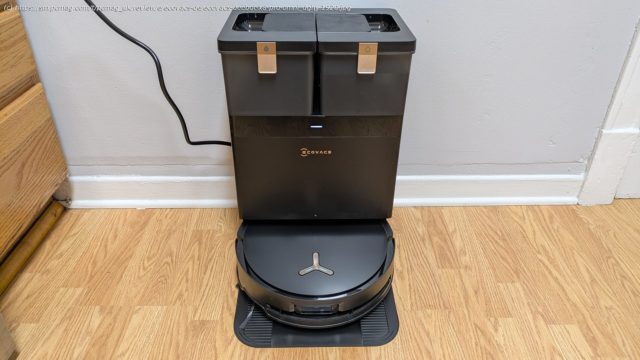A highly versatile robot that excels at mopping and vacuuming
The Ecovacs Deebot X8 Pro Omni is a premium robot vacuum and mop hybrid with lofty ambitions to outdo its predecessor, the excellent Ecovacs Deebot X2 Omni. It succeeds thanks to several notable upgrades, including a redesigned roller mop that washes itself as it works to limit cross-contamination, an automatic dispenser for mopping solution, and an extendable side brush for thorough edge cleaning. It also offers a significant increase in vacuum suction power while retaining the same fantastic self-maintenance features that helped the X2 Omni stand out. And at $1,299.99, the X8 Pro Omni costs $200 less than the X2 Omni at launch. With these changes, it’s easy to see why the Ecovacs Deebot X8 Pro Omni is our new Editors’ Choice winner for high-end hybrid robot vacuums.Features: A Roller Mop and More
Like its predecessor, the Ecovacs Deebot X8 Pro Omni can vacuum and mop on a single run. You can control it from the Ecovacs Home app (for Android and iOS), via Alexa or Google Assistant, or with voice commands to its built-in assistant, Yiko. For this generation, Yiko has been upgraded with AI software similar to popular chatbots to make it more natural to interact with.
After a cleaning run, the X8 Pro Omni returns to its base station and empties its dustbin. Then, the base station washes and dries the robot’s mop. It uses water heated between 104 and 167 degrees Fahrenheit from its clean water reservoir to wash the mop and then dries it with air heated to 145 degrees.
Between runs, you can use the camera built into the front of the X8 Pro Omni to take a look around. You can send it on an automated patrol or control it yourself from the app to look at something specific. You can also send it to clean specific rooms or areas by tapping that spot on your home’s map.
Like the Dreame X30 Ultra ($1,699.99) and the Roborock Qrevo Curv ($1,599.99), the X8 features a side brush and mop that extend out from its body to help it clean in corners and along wall edges. Aside from its clean and dirty water reservoir, the X8’s base has a separate detergent compartment like the Dreame X30, so it can precisely mix the amount of cleaning solution and water added to the vacuum’s mopping reservoir before a run.
Like the Qrevo Curv, the X8 can lift itself over thresholds. Specifically, it can handle steps as high as 0.79 inches, which helps it avoid getting stuck on obstacles. The Qrevo Curv is still more adept at navigating multi-level floorplans as it can clear a step as high as 1.6 inches tall.
The X8 has 18,000Pa of suction power, nearly matching the class-leading Curv (18,500Pa) and going well beyond the Dreame X30 (8,300Pa) and the X2 (8,000Pa).
The X8 sets itself apart with its redesigned roller mop. It eschews dual circular mop pads, a feature of the X2 and many other high-end hybrids like the Dreame X30 and the Qrevo Curv, in favor of an Ozmo Roller Instant Self-Washing Mop designed in collaboration with vacuum maker Tineco. Instead of spinning discs, the mop looks like a paint roller. It applies 4,000Pa of pressure to the ground as it spins at 200 rotations per minute (rpm). While it spins, a scraper whisks away the dirty water, and 16 nozzles keep it doused with fresh cleaning solution. Design: Premium Fare
At a glance, the Ecovacs Deebot X8 Pro Omni looks the part of a classy, high-end machine, with its elegant and mostly unadorned black design and matching modular black base station. I had been testing more affordable models recently, and when visiting friends saw the X8 in my kitchen, they commented that I must have moved back to the premium range without knowing any details.
The base measures 18.8 by 13.8 by 21.0 inches (LWH), roughly the same size as the X2’s dock (17.4 by 15.5 by 20.8 inches). The clean and dirty water tanks sit on top of the structure. An indicator light below the tanks shines solid white under most circumstances of ordinary use but flashes red in case of a malfunction and turns off if the robot loses power or goes into deep sleep mode.
Beneath the light is a hidden compartment containing the dust bag and detergent reservoir. You can access this compartment by pulling the lid from underneath the front side. The robot doesn’t come with any cleaning solution, but a 1-liter bottle from Ecovacs is available for $27.99.
Beneath that is the robot’s bay, with charging contacts lining the back wall and a self-cleaning mop washing tray on the bottom. The tray pulls free for seasonal maintenance cleaning by hand. A ramp to help the vacuum enter the base snaps onto the front of this enclosure. Around the back of the base is the slot for the power cord, an air vent, and a power switch.
The circular robot measures 13.9 by 13.8 by 3.9 inches (LWH), which is slightly bigger than the D-shaped X2 (12.6 by 13.9 by 3.7 inches) and roughly the same size as the Qrevo Curv (13.9 by 13.7 by 4.1 inches). At 11.7 pounds, it is heavier than the 8.6-pound Curv.
On the bottom, the roller mop fits into an open-ended slot on one side, allowing it to jut out and clean along walls. The main vacuum brush roll sits in the center of the bottom, with V-shaped bristles designed to help it pick up hair without accumulating tangles. The primary retracting wheels flank the brush roll, with an omnidirectional caster wheel at the front of the underbelly. The extendable side brush fills one front corner, and anti-drop sensors circle the perimeter.
A plain black cover with an Ecovacs symbol rests on top of the robot. Underneath the cover is a removable dustbin, a Wi-Fi indicator light, a QR code for setup, and a power switch. A three-prong control button also adorns the top and is visible even with the cover in place through a cutout. You can tap this panel once to start or pause cleaning, hold it for three seconds to cancel a job and send the robot back to the base station, or double-tap it to release the roller mop for manual cleaning or replacement.
A window on the front bumper offers a look at the X8’s various navigation sensors. It uses LiDAR for mapping and an artificial intelligence and visual interpretation (AIVI) 3D camera for navigation and obstacle detection, while edge sensors line the sides.






